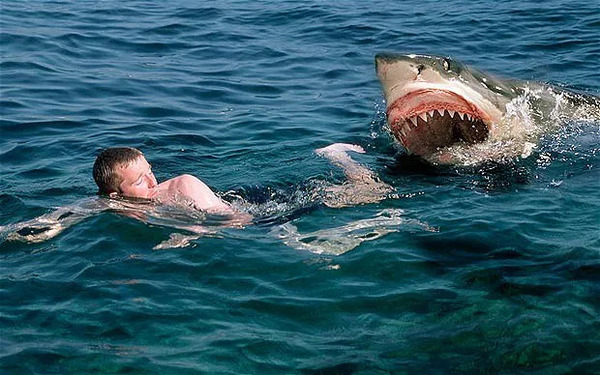When you're out in nature, whether hiking, camping, or simply exploring the wilderness, it's important to know how to react in the event of an animal attack. While the chances of encountering a dangerous animal are low, being prepared can make all the difference. In this guide, we'll cover how to survive attacks from some of the most common dangerous animals, with real-life examples to show why these tips matter.

Bears are one of the most feared animals, but most bear encounters don't lead to attacks. However, if you find yourself face-to-face with a bear, knowing how to react is crucial.
Stay Calm and Don’t Run: Running can trigger a bear’s chase instinct. Instead, stand your ground, and speak to the bear in a calm, low voice.
Identify the Type of Bear: If it's a black bear, make yourself look big and loud to scare it off. If it’s a grizzly bear, play dead by lying face down and covering your neck with your hands. Grizzlies usually stop attacking once they perceive no threat.
Example: In 2017, Todd Orr, a hiker from Montana, survived a grizzly bear attack by playing dead after the bear charged at him twice. By staying calm and following bear safety rules, he avoided more severe injuries.
Use Bear Spray: Bear spray is your best defense in case of a close encounter. Aim for the bear’s face and spray in short bursts.

Shark attacks are rare, but if you’re swimming or surfing in the ocean, it’s important to know how to protect yourself.
Stay Calm and Don’t Splash: Panic can attract the shark’s attention. Try to remain as still as possible and avoid making splashes.
Defend Yourself: If the shark comes close, aim for its eyes, gills, or snout. These are sensitive areas that may cause the shark to retreat.
Swim Slowly to Shore: If you can, swim back to shore calmly without making sudden movements.
Example: In 2020, surfer Nick Slater survived a shark attack in Australia by fighting off the animal with his surfboard, hitting it repeatedly until it swam away.

While many snakes are non-venomous, some, like rattlesnakes or cobras, can be dangerous.
Stay Still and Call for Help: If bitten, remain calm to slow the spread of venom. Call for medical assistance immediately.
Avoid Cutting the Wound or Sucking the Venom: These old myths are ineffective and can do more harm than good.
Keep the Affected Area Still: Keep the bitten limb below heart level and avoid moving it to reduce the spread of venom.
Example: In 2018, a Texas man was bitten by a rattlesnake while hiking. He remained calm, used a compression bandage, and was rushed to the hospital, which saved his life.

Mountain lions (or cougars) are stealthy predators, and while attacks on humans are rare, they can happen, especially if you’re hiking or running in their territory.
Don’t Run: Like with bears, running can trigger a mountain lion’s instinct to chase.
Make Yourself Big: Stand tall, wave your arms, and make yourself appear larger. Shout loudly to intimidate the lion.
Fight Back if Attacked: If the lion charges at you, defend yourself with sticks, rocks, or any available objects. Aim for the lion’s head and eyes.
Example: In 2019, a Colorado man named Travis Kauffman fought off a mountain lion with his bare hands after it attacked him while he was jogging. He was able to defend himself and survive by choking the lion.

Elephants are generally peaceful animals but can be highly dangerous when provoked or threatened.
Observe Warning Signs: Elephants usually give warning signals before charging, such as flapping ears or making loud trumpeting sounds.
Stay Calm and Retreat: Slowly back away while facing the elephant. Don’t turn and run.
Seek Cover: If the elephant charges, find a large object like a tree or a rock to hide behind. Elephants will often stop the charge if they no longer feel threatened.
Example: In 2017, a group of tourists in Africa survived an elephant charge by calmly retreating to their vehicle and staying quiet until the elephant lost interest.

Crocodiles and alligators can be extremely aggressive, especially if you're in their territory.
Stay Out of the Water: Avoid swimming or wading in areas known to have crocodiles or alligators.
If Attacked, Fight Back: Use anything available to strike the animal on its eyes or snout.
Roll with the Croc: If the crocodile performs its death roll (a spinning motion to drown prey), try to roll with it rather than resist to avoid injury.
Example: In 2022, a man in Florida survived an alligator attack by poking it in the eyes with his fingers, forcing the animal to let go.
While encountering a dangerous animal is rare, it’s vital to be prepared with the right knowledge. By staying calm, understanding animal behavior, and knowing when to defend yourself, you can greatly increase your chances of surviving an attack. Remember, animals typically don’t want to harm humans and often attack only when they feel threatened. Respect their space, be cautious, and enjoy nature responsibly!
animal tags: Bear
We created this article in conjunction with AI technology, then made sure it was fact-checked and edited by a Animals Top editor.